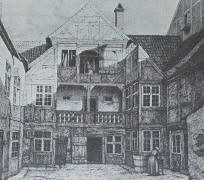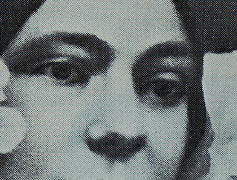|
How it all began
But before we hear how the story ends we
must have the beginning.
During his journey in Funen, on those
August days shortly before meeting
Riborg,
he had been studying churches and church
art. In
St Nicholas Church in Svendborg, for
instance, he had seen a painting that he
describes in his diary under August 5.
It was painted by a clergyman and
depicts a clergyman and his wife with
their many children. Besides the living
children, he had also painted the
family's three dead babies; an odd
feature, like the other that all the
children are good-looking except one of
the boys. The ugly boy, however, had
been painted holding arose, " as if to
give him with that at least something
beautiful," he says of the picture in
his novel Only a Fiddler. The boy
with the rose is the image of the boy
violinist Christian. What the rose is
for the boy in the painting, the violin
is meant to be for the poor boy in the
novel.
Collin's
house in Copenhagen.
'Give
me a bride! My blood wants love, as my
heart does'
Hans Brix, whose thesis on Andersen of
1907 has been reissued as a paperback in
1970, did some detective work on this
picture, which he thinks Andersen must
have seen while still a boy, on a
journey to a sacred spring near
Svendborg that he carefully conceals.
Brix thinks he did so because he was
anxious to keep secret any feature that
would indicate the neurasthenia which
tormented him even as a boy. (Why he
conceals this is not discussed by the
professor. The reason may be the simple
one that he rightly feared that to
reveal this" secret" would, in certain
eyes, brand his entire production as
overstrained and peculiar.)
This journey, therefore, recalled for
Andersen memories of a journey twelve
years before, memories which also
include a magnificent wedding procession
through Svendborg; and one can imagine
the mood this fresh encounter must have
evoked in him. A mood of having been
away, on the ocean bed, while life was
going on and other people were having
both brides and children. In this
respect, his own life was like a static
painting. The entry in the diary
describing the family portrait ends thus:
"On either side, old tombstones, and, on
the left, a black one which looks like
the plate of an iron stove. Almighty
God, thee only have I; thou steerest my
fate, I must give myself up to thee!
Give me a livelihood! Give me a bride!
My blood wants love, as my heart does! "
Attention has been drawn
to another painting, which he saw on the
same day; a picture of a woman, whose
blooming beauty had such a powerful
effect because he was forcibly reminded
that now she was dust. The painting of
the clergyman's living and dead children
probably contributed to this sombre mood
also. And in the singular tombstone "which
looks like the plate of an iron stove"
we indeed have the whole mood
concentrated. It will be no accident
that it leads straight to the plea for a
bride and a livelihood.
The stove is one of his constant symbols
of domestic love and warmth, as in a
further sense is the stork: the home
bird that is also allowed to travel a
little away from home. Andersen's
prudishness with regard to the erotic
was not an external convention. Love,
longing for a bride, in him were deeply
associated with the dream of the home
that he had to leave so early, and that
was so quickly broken up.
There are plenty of elements in this "old
curiosity shop" of pictures to explain
the exaltation, the dilemma in the
subsequent love situation. Everything
about him must have cried out to him:
"Life is running out! Hasten! Take care!
You have only your little rose to hold
on to."
 Nevertheless
he wrote his letter of proposal that
autumn. Riborg was moved, and tears
flowed; the young pair seem to have
nearly drowned each other in a flood of
tears. To add to the story, Riborg's
parents had at last consented to the
chemist's son; he is there waiting for
her when she returns home with the
fervent letter of proposal. Evidently,
anything is better than this odd poet
with the popping eyes and elephant feet
who would be capable of declaiming and
trampling any decent home to bits if he
got into it. Nevertheless
he wrote his letter of proposal that
autumn. Riborg was moved, and tears
flowed; the young pair seem to have
nearly drowned each other in a flood of
tears. To add to the story, Riborg's
parents had at last consented to the
chemist's son; he is there waiting for
her when she returns home with the
fervent letter of proposal. Evidently,
anything is better than this odd poet
with the popping eyes and elephant feet
who would be capable of declaiming and
trampling any decent home to bits if he
got into it.
Riborg's answer was a tear-stained No.
Riborg Voigt
"Now I shall never
get married. No young girl grows for me
any more"
|